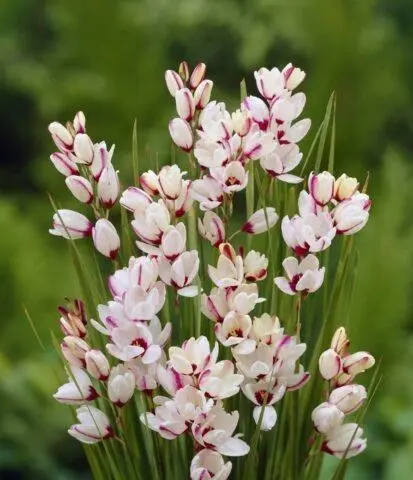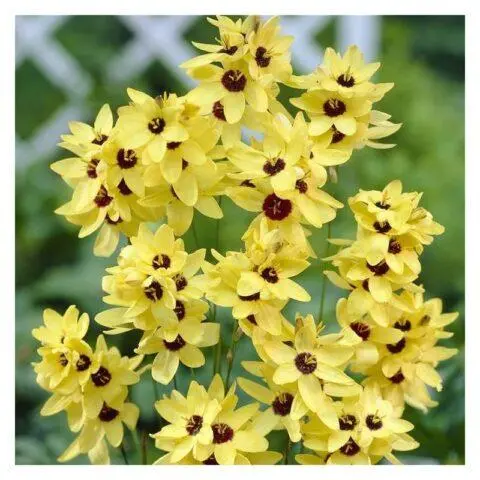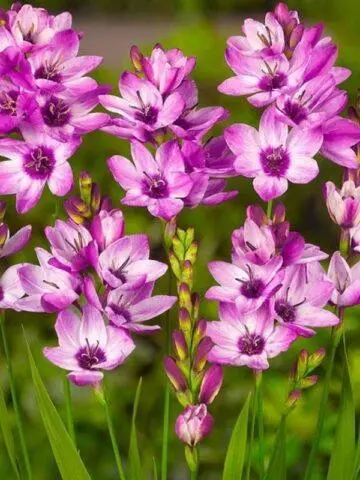Contents
Planting and caring for ixia in the open field requires the gardener to have certain skills and knowledge. To succeed in growing a flower, you should study its characteristics and features of agricultural technology.
Description of ixia with a photo
The plant belongs to the Iris family. The origins of the flower are considered to be Africa, where there are more than 50 species of ixia. In the people, its synonymous name is Velcro. This fact can be explained by the characteristics of the plant: the juice in the stems is very sticky.
Before planting ixia, it should be noted that most of its species grow no more than 0,5 m in height. The leaves are narrow and wedge-shaped, with a sticky juice that stands out. The stems are thin, decorated with star-shaped flowers, collected in spikelets.
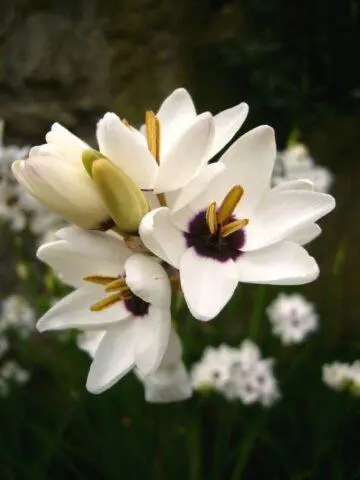
If the ixia is planted in the fall, it will bloom in the spring, and if the plant is transferred to the open ground in May, then the buds can be seen in August
Species and varieties
A huge variety of colors for a flower allows the owner to create an interesting design on his site. Velcro can be planted both alone and in whole groups, combining different varieties with each other.
One of the most exotic varieties of culture is the green-flowered ixia (Ixia viridiflora). The bush has bright green sword-shaped leaves, and the flowers have six petals of a pale green color with a purple center.
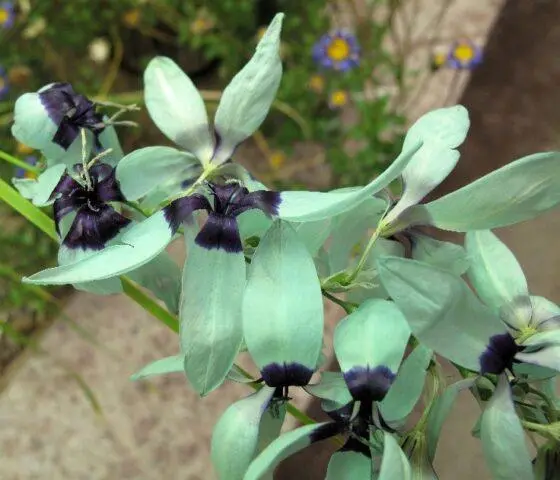
The peculiarity of the green-flowered ixia is its uniqueness; it is very difficult to acquire planting material
In the Far East, there is another interesting variety of flower. Chinese Ixia (Ixia chinensis) is on the verge of extinction. The plant has a short rhizome and long shoots, from 50 to 150 cm each. They have broad xiphoid leaves attached to them. The buds are reddish-brown or yellow with a dark purple speck.
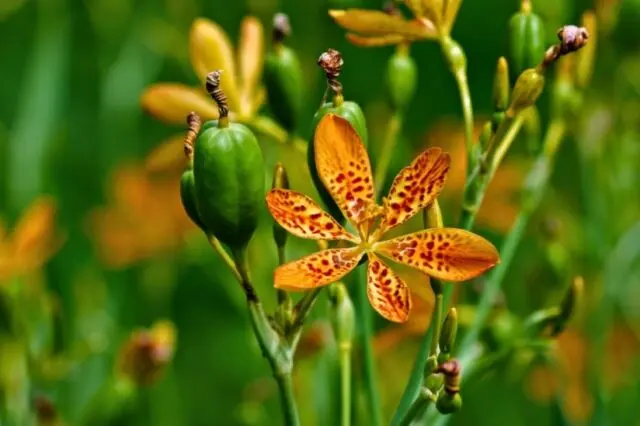
Before planting Chinese ixia, one should take into account its peculiarity: a flower that has blossomed in the morning will fade by evening
There is a species that has become known in the world since 1770. Ixia hybrid (Ixia x hybrida) is a perennial whose height does not exceed 30-50 cm. The leaves are arranged in two rows, funnel-shaped flowers are collected in spikes or brushes on peduncles.
The flowering time of hybrid ixia is three weeks, and its most popular varieties are as follows:
- Ixia Spotlight (Ixia Spotlight) is characterized by erect inflorescences of a white-crimson hue. In total, 20 or more pieces can be formed on the shoot. Outwardly, a blossoming bud resembles an apple tree, therefore it is very popular among florists.

Ixia Spotlight blooms for over four weeks
- Ixia Yellow Emperor is better known as the golden corn lily. The buds of the variety are graceful, bright yellow in color, in the center of a dark bronze hue. Characteristic of the variety is a very rich pleasant aroma.

Ixia Yellow Emperor is best planted in a rock garden, but growing in flowerpots or rockeries is also possible.
- Ixia Panorama is one of the low varieties of culture. The length of the shoots does not exceed 30-40 cm. 10-12 buds with a pale pink tint are formed on the peduncle. Their base is red. In diameter, the flowers are not more than 3-4 cm each. The exoticism of the variety is a pleasant aroma and the ability of buds to close with sunset and bloom in the morning.

Frost resistance of Ixia Panorama reaches -30 °С
A multi-colored mix is very popular among gardeners. Ixia has large inflorescences up to 7 cm in diameter. But the shades of the petals can be white, pink, rich red and even yellow or burgundy.

It is a fact, but the flowering of ixia depends not only on planting and care, but also on the climate: the buds do not open in cloudy weather
When to plant ixia
If you need to plant the bulb in an area where the climate is warm and mild, then the ideal time for the procedure is April-May. Autumn planting is also allowed, followed by departure in November.
Planting ixia in open ground
To grow a culture, you need to provide it with all the necessary conditions. It is necessary to rely not only on the general principles of agricultural technology, but also take into account individual varietal characteristics.
Choosing a landing place
Taking care of the plant will not be enough for it to grow quickly and bloom for a long time. It is necessary to allocate a sunny place to the culture, far from the trees, well protected from the wind.
Soil Preparation
It is best to plant ixia in fertile or neutral soil. If the soil mixture is heavy, then sand should be added to it during the preparation of the flower bed. The bed needs to be leveled, to make sides.
Rules of landing
The material should be sorted out: you need to leave elastic and dense bulbs without signs of rot and damage.
Algorithm for planting and caring for ixia at home:
- Make holes, fill their bottom with a layer of nutrient soil. You need to deepen each bulb by 50-80 cm. The distance between them should be 10-12 cm.
- Cover the tubers with a layer of organic mulch 20-30 mm thick.
- Watering the flower bed on the day of planting should not be. You can carry out the procedure after seven days.
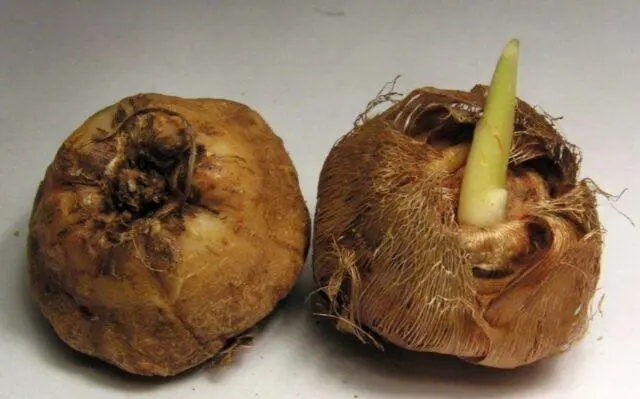
The number of flowering shoots depends on the size of the tubers and care: specimens with a circumference of 5 cm or more produce three shoots
Ixia care in the open field
The plant is considered to be unpretentious, but you need to know a number of nuances. In addition to basic care, ixia needs favorable climatic conditions after planting: light, warmth and humidity. In autumn and spring, you can pay less attention to the plant than in summer.
Watering
During the period of budding and flowering, ixia should be watered daily. On hot days, late in the evening and in the morning, in addition to basic care, it is recommended to irrigate the bushes from a spray bottle with water.
Additional fertilizing
When growing ixia mix, fertilizing should not be neglected. During the care of the plant, it is required to alternate mineral and organic compounds, making them in accordance with the instructions.
Wintering
In areas with a warm climate, it is allowed to leave the tubers in the ground after planting. First you need to provide the plant with shelter.
In other regions, ixias should be removed from the soil in late September or early October.
Algorithm of actions:
- After the inflorescences have faded, the bush is not touched until the leaves dry.
- Remove tubers, clean, sort. It is recommended to pack the planting material in a paper bag, then no further care is required.
- The optimum storage temperature for tubers is +5 °C.
Ixia in the greenhouse
It is possible to plant a flower in a pot or greenhouse. The only problem a gardener will face is providing adequate lighting and maintenance.

Phytolamp makes it possible to highlight the plant at any time
Planting ixia at home
If you decide to grow a crop at home, then you need to prepare a spacious pot with well-drained soil. Water should not stagnate.
The optimal time for planting ixia mix is uXNUMXbuXNUMXbthe beginning of May. To see the flowers as in the photo, you need to provide complete care: water and feed, remove dried leaves, cut wilted buds.
Reproduction of ixia
Garden and hybrid varieties can be propagated with good care with the help of tuber babies. It is best to carry out the division procedure in May, when the risk of frost disappears, in order to immediately plant the resulting material. Botanical species can be propagated by seed.
Diseases and pests
Thrips are capable of destroying the plant, which prefer to winter in the scales of planting material.
Outwardly, they look like bugs of an elongated shape. The color of the shell varies depending on the species: from black to burgundy. There are pests with a transparent body and small wings.
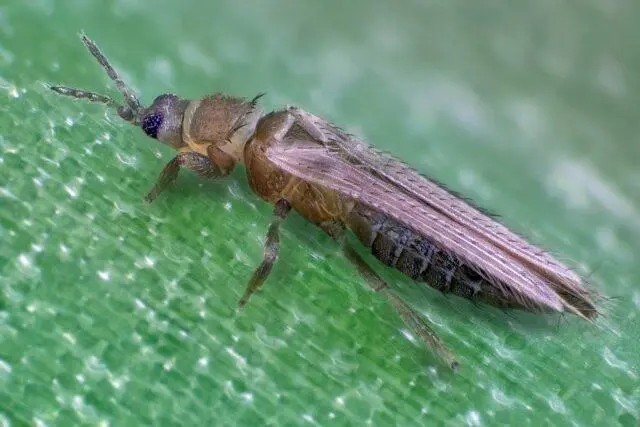
Thrips lead a hidden lifestyle, hiding under the leaves or in the stem, creating entire colonies.
The best way to kill pests is prevention and proper care. Tubers before wintering should be treated with naphthalene after drying and cleaning. Store the bulbs for three weeks at a temperature of +21 ° C, and then transfer to a cool room until the next planting.
The active drugs against thrips are Aktara or Vertimek.
Conclusion
Planting and caring for ixia in the open field requires care and patience from the gardener. The abundance of flowering depends not only on watering and top dressing, but also on weather conditions. In southern latitudes, it is easier to grow a flower than in middle or northern regions, even with minimal care.










